Strong Modulation of Short Wind Waves and Ka-Band Radar Return Due to Internal Waves in the Presence of Surface Films. Theory and Experiment
Abstract
:1. Introduction
2. Theory
2.1. Modulation of Surfactant Concentration Due to Internal Waves
2.2. A Hydrodynamic Model of the Wind Wave Spectrum and Its Modulation
2.3. A Model of Microwave Radar Backscatter from the Sea Surface
3. Wave Tank and Field Experiments
3.1. Wave Tank Experiments
3.2. Field Experiments
3.3. Data Processing
4. Results
4.1. Wave Tank Experiments
4.1.1. Modulation of Surfactant Concentration Due to IW
4.1.2. Ka-Band Radar Probing of Wind Waves
Radar Contrasts
Radar Modulation Transfer Function
4.2. Field Observations
5. Discussion
6. Conclusions
- A phenomenological model of the modulation of short wind waves and Ka-band radar return due to internal waves in the presence of surfactant films has been elaborated. Wave tank studies on the IW modulation of surfactant concentration and of radar backscatter in the field of IW orbital currents were carried out for two different cases. In the first case, the IW phase velocity was large compared to the velocity of surfactant films due to wind drift; in the second case, these velocities were close to each other—non-resonance and resonance cases, respectively. It has been shown theoretically and in experiments that surfactants at resonance were strongly comparable to non-resonance cases concentrated over the IW troughs or the rear slopes of IW;
- It has been observed that Ka-band radar backscatter was reduced when a film was applied on water and the radar contrast increased with surfactant concentration and, in practice, did not depend on whether resonance on non-resonance conditions were realized;
- Modulation of radar return (the radar modulation transfer function) practically did not depend on surfactant concentration for non-resonance case, but strongly increased with concentration at resonance. The results were explained by different modulation mechanisms for these two cases, i.e., the straining modulation of wind waves due to IWs was a dominant mechanism for non-resonance cases, whereas the modulation of radar return at resonance was determined mostly by the strong modulation of surfactants. In both cases, the radar backscatter was modulated due to variations of parasitic capillary ripples generated by steep cm–dm-scale waves (cascade modulation), rather than of free Bragg capillary mm-scale waves. Some field observations have been presented, which qualitatively confirmed the effect of strong modulations of Ka-band radar backscatter due to IWs in the presence of resonance drift of surfactant films;
- It has been shown that the developed modulation model was consistent with experimental results;
- The mechanism of strong (cascade) modulation of microwave Ka-band radar backscatter studied in this paper is very important for correct interpretations of IW signatures in radar imagery of the sea surface. The quasi-linear models of hydrodynamic straining modulation combined with Bragg theory underestimate the IW radar signature contrasts, whereas the proposed cascade model, taking into account the strong nonlinearity of short wind waves, gives more realistic values of the contrasts and the RMTF. We plan to extend the model in the future to a wider range of wind wave spectra in order to explain IW signatures in satellite imagery in X/S radar bands.
Author Contributions
Funding
Conflicts of Interest
References
- Alpers, W. Theory of radar imaging of internal waves. Nature 1985, 314, 245–247. [Google Scholar] [CrossRef]
- Thompson, D.R.; Gasparovic, R.F. Intensity modulation in SAR images of internal waves. Nature 1986, 320, 345–348. [Google Scholar] [CrossRef]
- Da Silva, J.C.B.; Ermakov, S.A.; Robinson, I.S.; Jeans, D.R.G.; Kijashko, S.V. Role of surface films in ERS SAR signatures of internal waves on the shelf: Part 1. Short-period of internal waves. J. Geophys. Res. 1998, 103, 8009–8031. [Google Scholar] [CrossRef]
- Romeiser, R.; Graber, H.C. Advanced Remote Sensing of Internal Waves by Spaceborne Along-Track InSAR—A Demonstration With TerraSAR-X. IEEE Trans. Geosci. Remote Sens. 2015, 53, 6735–6751. [Google Scholar] [CrossRef]
- Lavrova, O.; Mityagina, M. Satellite survey of internal waves in the Black and Caspian Seas. Remote Sens. 2017, 9, 892. [Google Scholar] [CrossRef] [Green Version]
- Hughes, B.A.; Grant, H.L. The effect of internal waves on surface wind waves. 1. Experimental measurements. J Geophys. Res. 1978, 83, 443–454. [Google Scholar] [CrossRef]
- Voronovich, A.G. Strong solitary internal waves in a 2.5-layer model. J. Fluid Mech. 2003, 474, 85–94. [Google Scholar] [CrossRef]
- Basovich, A.Y.; Bakhanov, V.V.; Talanov, V.I. Transformation of wind-driven wave spectra by short internal wave trains. Izv. Acad. Sci. USSR Atmos. Ocean. Phys. 1987, 23, 520–528. [Google Scholar]
- Lewis, J.E.; Lake, B.M.; Ko, D.R. On the interaction of internal waves and surface gravity waves. J. Fluid Mech. 1974, 63, 773–800. [Google Scholar] [CrossRef]
- Ermakov, S.A.; Salashin, S.G. On the effect of strong modulation of capillary-gravity ripples by internal waves. Doklady AN 1994, 337, 108–111. [Google Scholar]
- Ewing, G. Slicks, surface films and internal waves. J. Mar. Res. 1950, 9, 161–187. [Google Scholar]
- Ermakov, S.A.; Pelinovsky, E.N. Variation of the spectrum of wind ripple on coastal waters under the action of internal waves. Dyn. Atmos. Ocean. 1984, 8, 95–100. [Google Scholar] [CrossRef]
- Ermakov, S.A.; Panchenko, A.R.; Salashin, S.G. Film Slicks on the Sea Surface and Some Mechanisms of Their Formation. Dyn. Atmos. Ocean. 1992, 16, 279–304. [Google Scholar] [CrossRef]
- Ermakov, S.A.; da Silva, J.C.; Robinson, I.S. The role of surface films in SAR signatures of internal waves on the shelf II. Internal tidal waves. J. Geophys. Res. 1998, 103, 8033–8043. [Google Scholar]
- Gade, M.; Alpers, W.; Ermakov, S.A.; Huhnerfuss, H.; Lange, P.A. Wind-wave tank measurements of bound and freely propagating short gravity-capillary waves. J. Geophys. Res. 1998, 103, 21697–21710. [Google Scholar] [CrossRef]
- Rosenberg, A.; Ritter, M.; Melvillle, W.K.; Gottschall, K.; Smirnov, A. Free and bound capillary waves as microwave scatterers: Laboratory studies. IEEE Trans. Geosci. Remote Sens. 1999, 37, 1052–1065. [Google Scholar] [CrossRef] [Green Version]
- Perlin, M.; Lin, H.; Ting, C.L. On parasitic capillary waves. J. Fluid Mech. 1993, 255, 597–620. [Google Scholar] [CrossRef]
- Cox, C.S. Measurements of slopes of high-frequency wind waves. J. Mar. Res. 1958, 16, 199–225. [Google Scholar]
- Longuet-Higgins, M.S.L. The generation of capillary waves by steep gravity waves. J. Fluid Mech. 1963, 16, 138–159. [Google Scholar] [CrossRef]
- Longuet-Higgins, M.S.L. Parasitic capillary waves: A direct calculation. J. Fluid. Mech. 1995, 301, 79–107. [Google Scholar] [CrossRef]
- Longuet-Higging, M.S.L.; Cleaver, R. Crest instability of gravity waves. Part 1. The almost highest wave. J. Fluid Mech. 1994, 258, 115–129. [Google Scholar] [CrossRef]
- Kudryavtsev, V.N.; Hauser, D.; Caudal, G.; Chapron, B. A semiempirical model of the normalized radar crosssection of the sea surface: 2. Modulation transform function. J. Geophys. Res. 2003, 108, 25–45. [Google Scholar]
- Kudryavtsev, V.; Akimov, D.; Johannessen, J.A.; Chapron, B. On radar imaging of current features. Part 1: Model and comparison with observations. J. Geophys. Res. 2005, 110, C07016. [Google Scholar] [CrossRef] [Green Version]
- Ermakov, S.A.; Sergievskaya, I.A.; Shchegolkov, Y.B. A laboratory study of strong modulation of radar signals due to long waves on the water surface covered with a surfactant film. Radiophys. Quantum Electron. 2002, 45, 942–957. [Google Scholar] [CrossRef]
- Ermakov, S.A.; Sergievskaya, I.A.; Zuikova, E.M.; Shchegolkov, Y.B. Modulation of radar backscatter by long waves on the sea surface covered with a surfactant film. Izv. Atmos. Ocean. Phys. 2004, 40, 91–98. [Google Scholar]
- Yermakov, S.A.; Ruvinsky, K.D.; Salashin, S.G. Local correlation of the characteristics of ripples on the crest of capillary gravity waves with their curvature. Izv. Atmos. Ocean. Phys. 1988, 24, 561–563. [Google Scholar]
- Levich, V.G. Physicochemical Hydrodynamics; Prentice-Hall: Englewood Cliffs, NJ, USA, 1962; 591p. [Google Scholar]
- Plant, W.J. A relationship between wind stress and wave slope. J. Geophys. Res. 1982, 87, 1961–1967. [Google Scholar] [CrossRef]
- Donelan, M.A.; Pierson, W.J., Jr. Radar scattering and equilibrium ranges in wind-generated waves with application to scatterometry. J. Geophys. Res. 1987, 92, 4971–5029. [Google Scholar] [CrossRef]
- Ermakov, S.A.; Ruvinsky, K.D.; Salashin, S.G.; Freidman, G.I. Experimental investigations of the generation of capillary-gravity ripples by strongly nonlinear waves on the surface of a deep fluid. Izv. Acad. Sci. USSR Atmos. Ocean. Phys. 1986, 22, 835–867. [Google Scholar]
- Kudryavtsev, V.; Chapron, B.; Myasoedov, A.; Collard, F.; Johannessen, J. On dual co-polarized SAR measurements of the Ocean surface. IEEE Geosci. Remote Sens. Lett. 2013, 10, 761–765. [Google Scholar] [CrossRef]
- Ermakov, S.A.; Sergievskaya, I.A.; Da Silva, J.C.; Kapustin, I.A.; Shomina, O.V.; Kupaev, A.V.; Molkov, A.A. Remote Sensing of Organic Films on the Water Surface Using Dual Co-Polarized Ship-Based X-/C-/S-Band Radar and TerraSAR-X. Remote Sens. 2018, 10, 1097. [Google Scholar] [CrossRef] [Green Version]
- Valenzuela, G.R. Theories for the interaction of electromagnetic and oceanic waves—A review. Bound.-Layer Meteorol. 1978, 13, 61–85. [Google Scholar] [CrossRef]
- Sergievskaya, I.A.; Ermakov, S.A.; Lazareva, T.N.; Guo, J. Damping of surface waves due to crude oil/oil emulsion films on water. Mar. Pollut. Bull. 2019, 146, 206–214. [Google Scholar] [CrossRef]
- Ermakov, S.A.; Kijashko, S.V. Laboratory study of the damping of parametric ripples due to surfactant films. In Marine Surface Films; Gade, M., Huehnerfuss, H., Korenovski, G., Eds.; Springer: Dordrecht, The Netherlands, 2006; pp. 113–128. [Google Scholar]
- Hara, T.; Plant, W.J. Hydrodynamic modulation of short wind wave spectra by long waves and its measurement using microwave backscatter. J. Geophys. Res. 1994, 99, 9767–9784. [Google Scholar] [CrossRef]
- Ermakov, S.A.; Sergievskaya, I.A.; Dobrokhotov, V.A.; Kapustin, I.A.; Kupaev, A.V. On the physical nature of Ka-band microwave backscattering due to wavy water surface. Curr. Probl. Remote Sens. Earth Space 2019, 16, 235–241. [Google Scholar]
- Ermakov, S.A.; Sergievskaya, I.A.; Dobrokhotov, V.A.; Lazareva, T.N. Wave tank study of steep gravity-capillary waves and their role in Ka-band radar backscatter. IEEE Trans. Geosci. Remote Sens. 2021, in press. [Google Scholar] [CrossRef]
- Phillips, O.M. The Dynamics of the Upper Ocean; Cambridge University Press: London, UK, 1977; 269p. [Google Scholar]
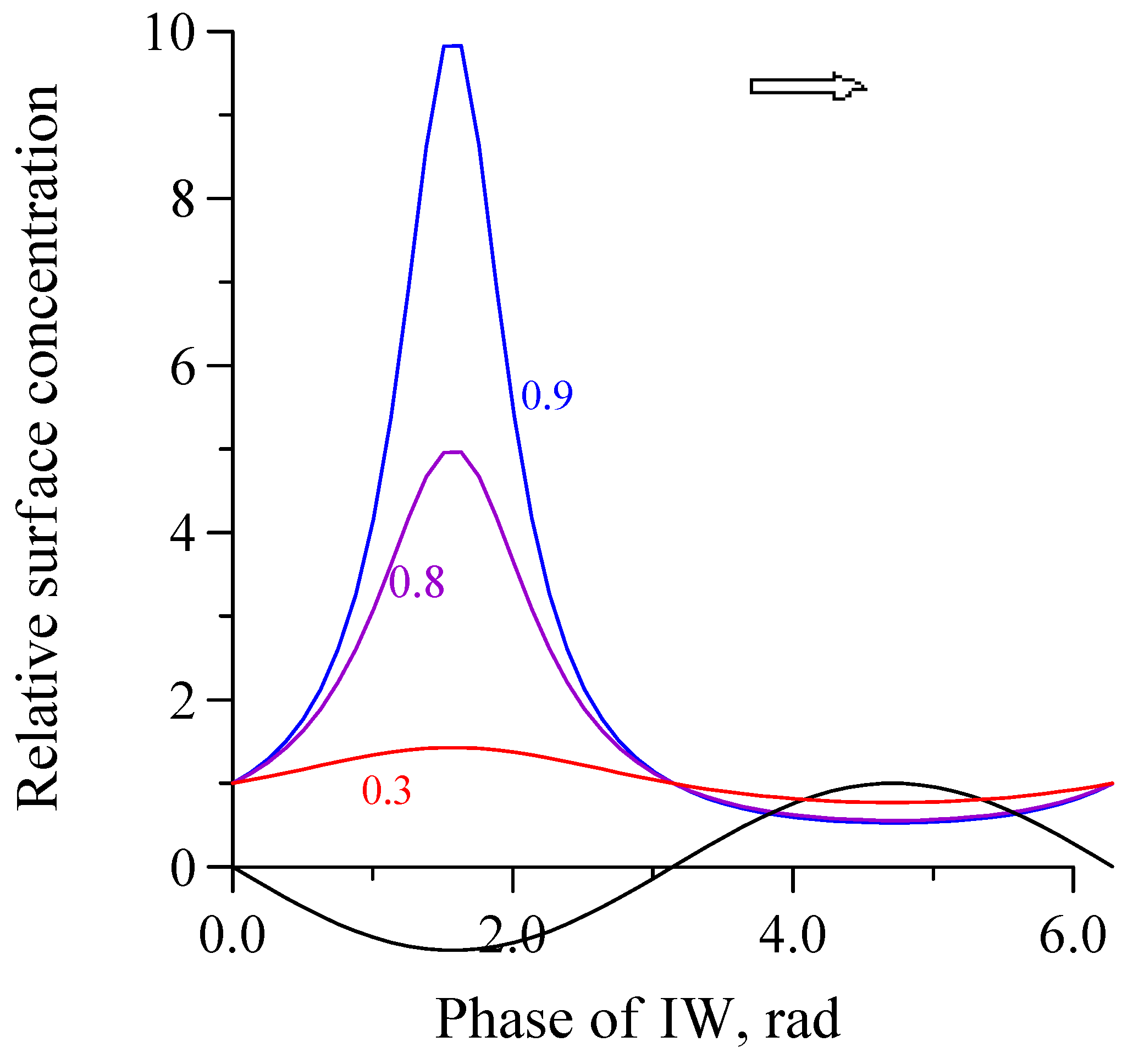
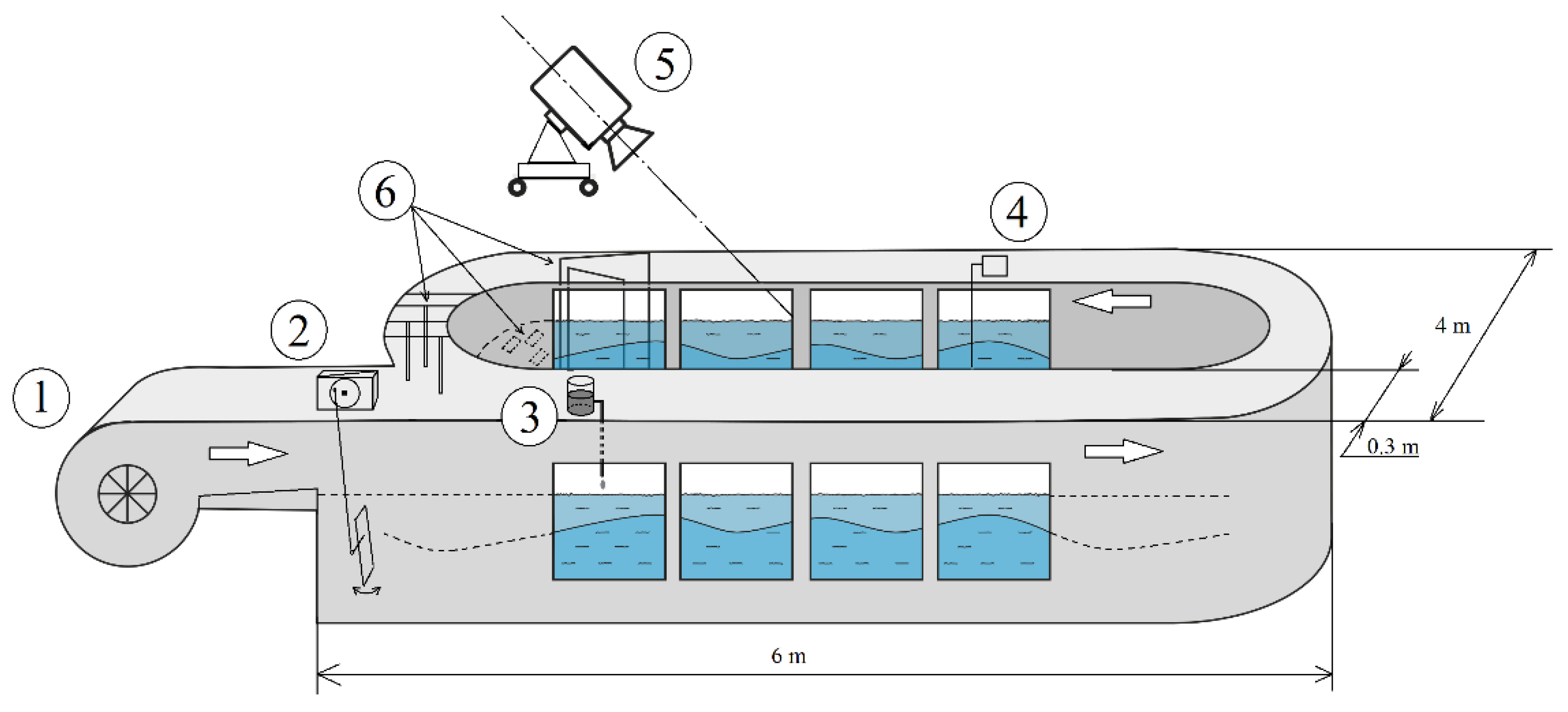

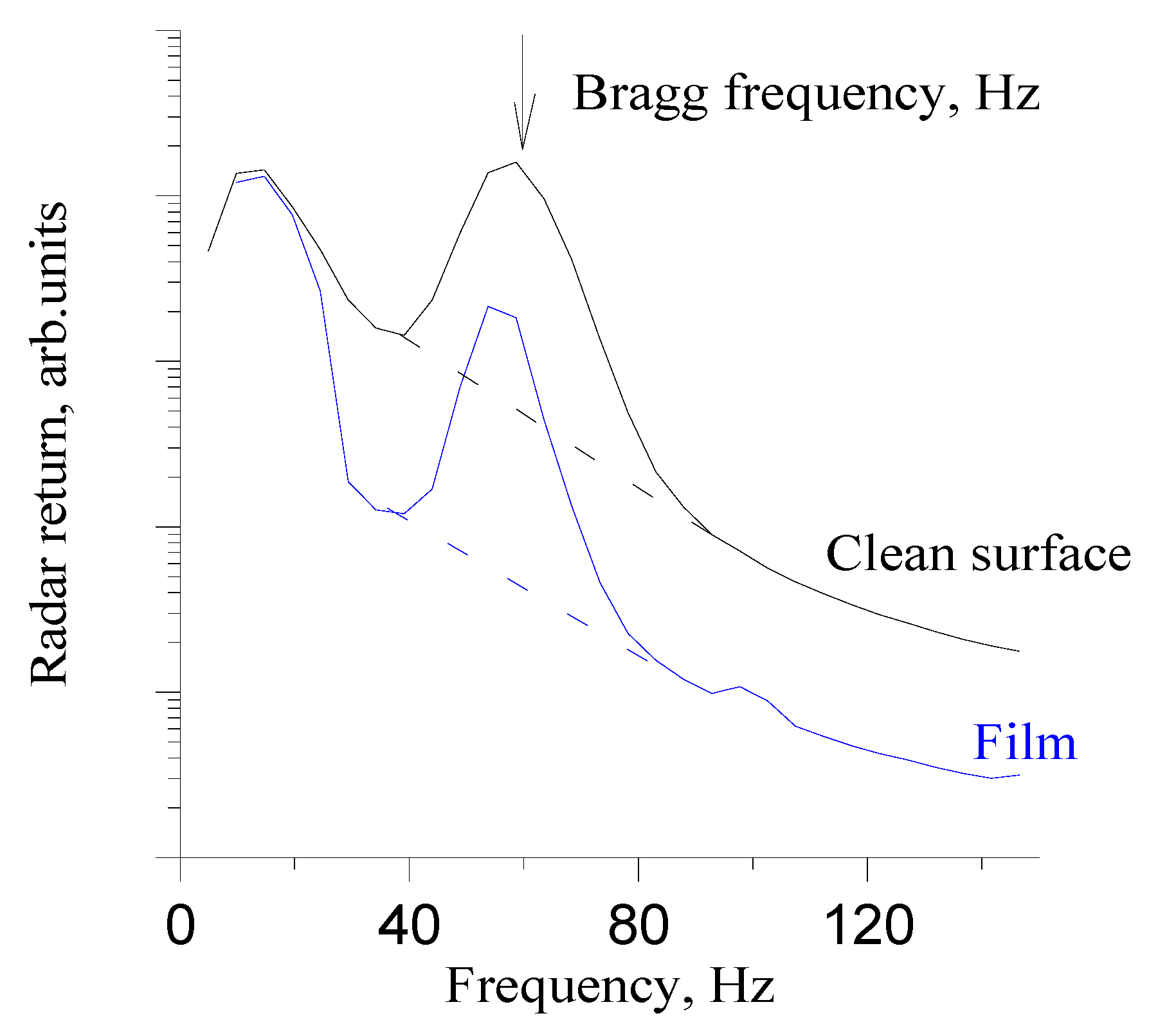
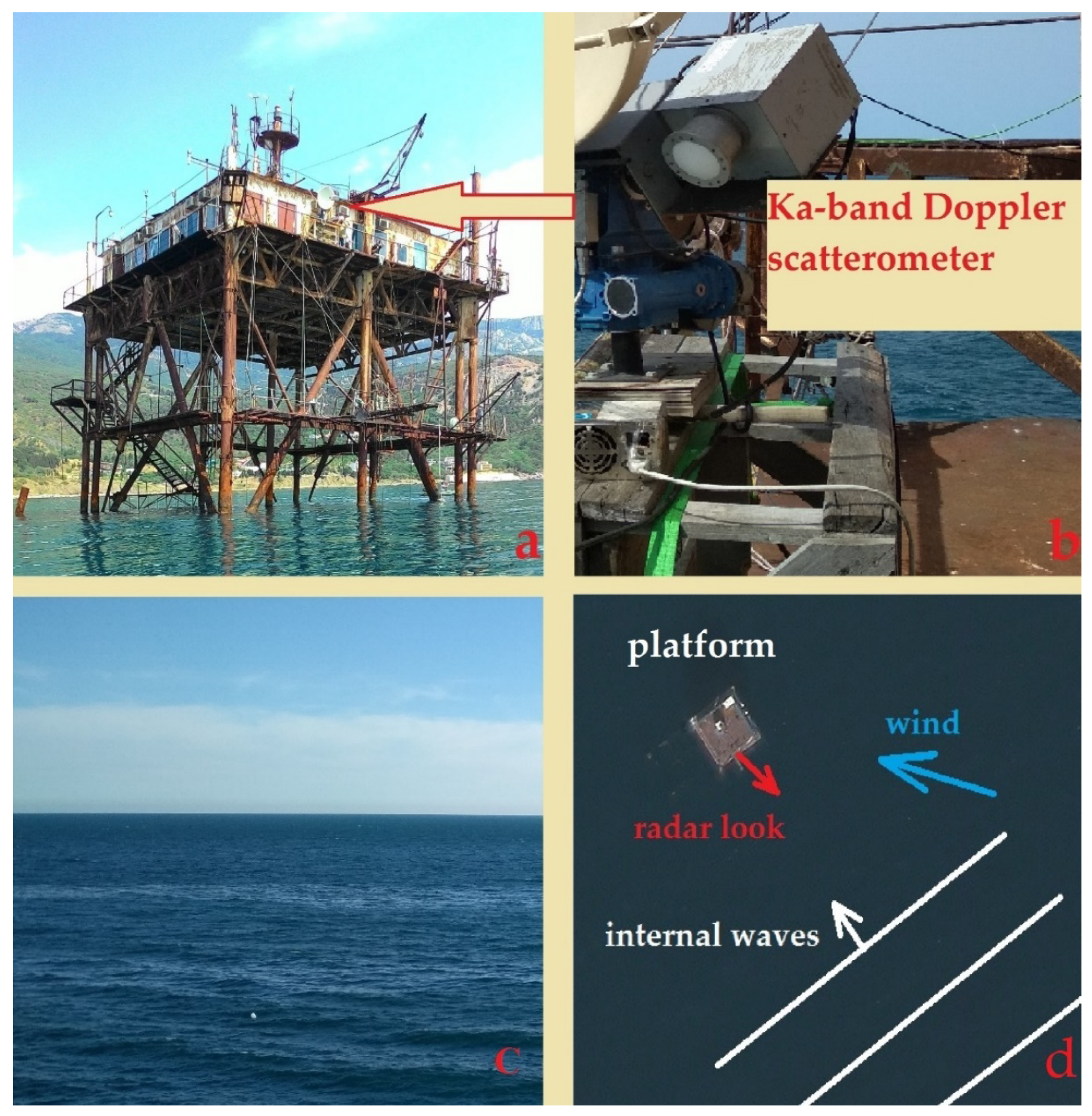
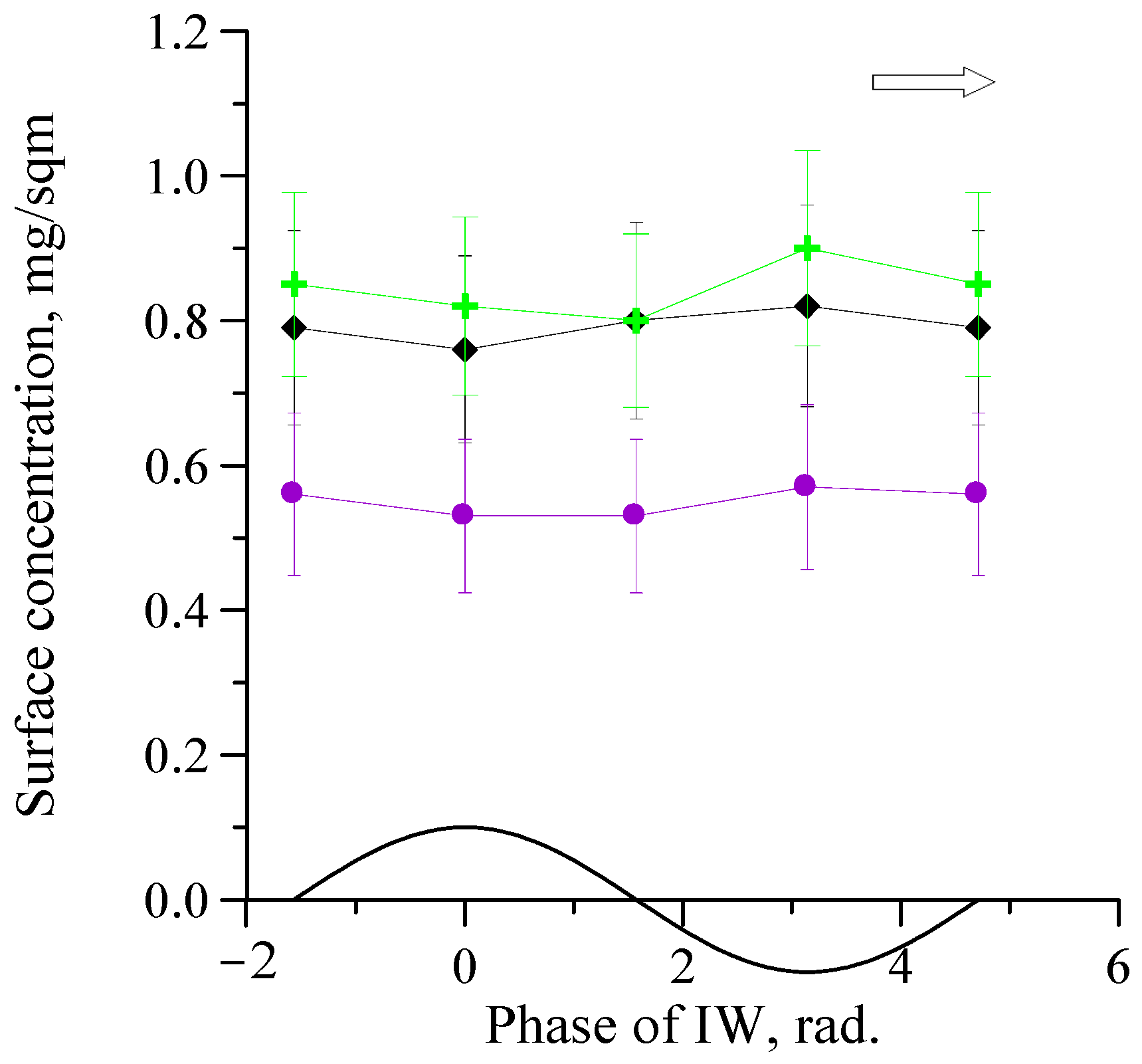

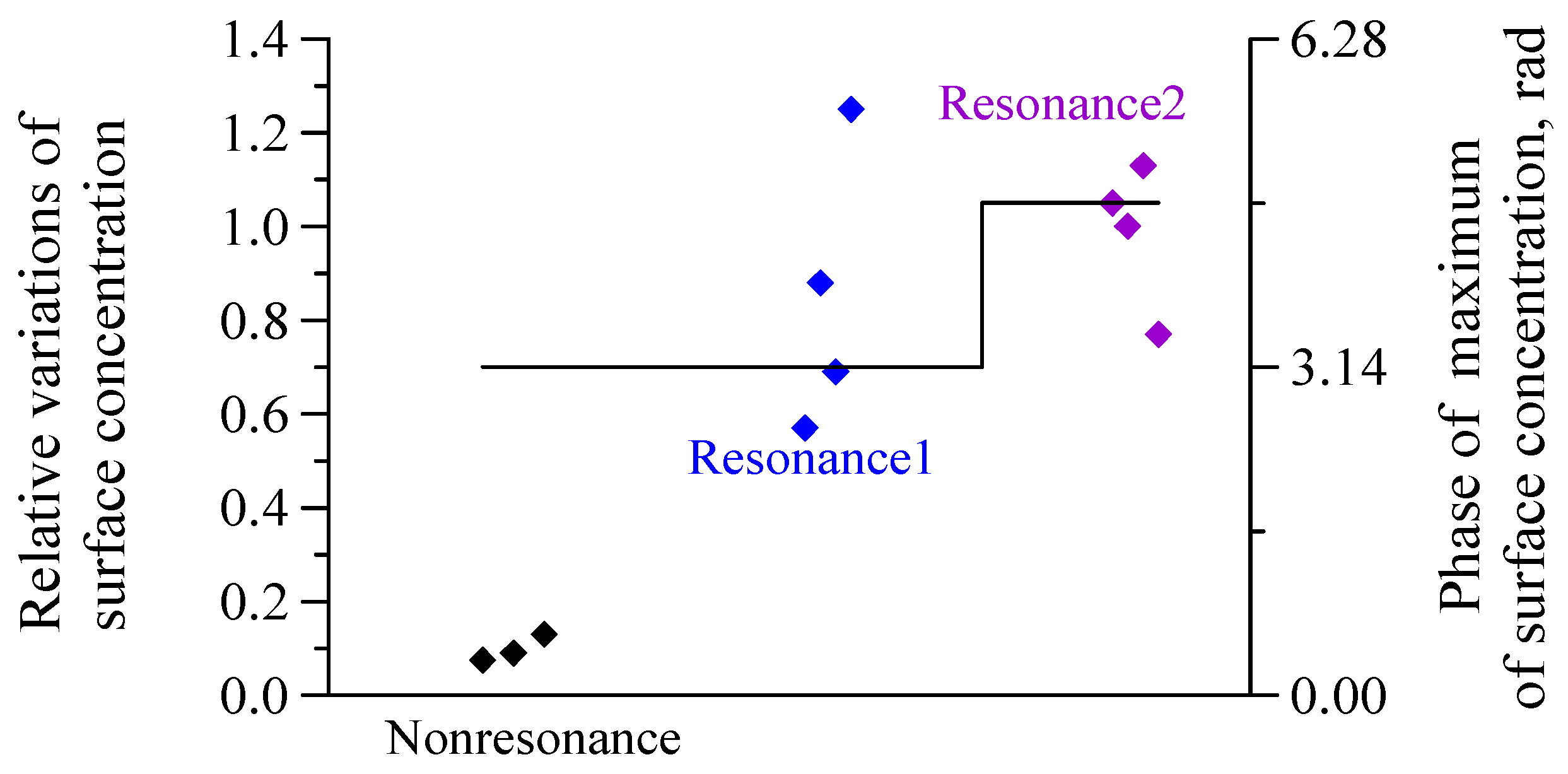

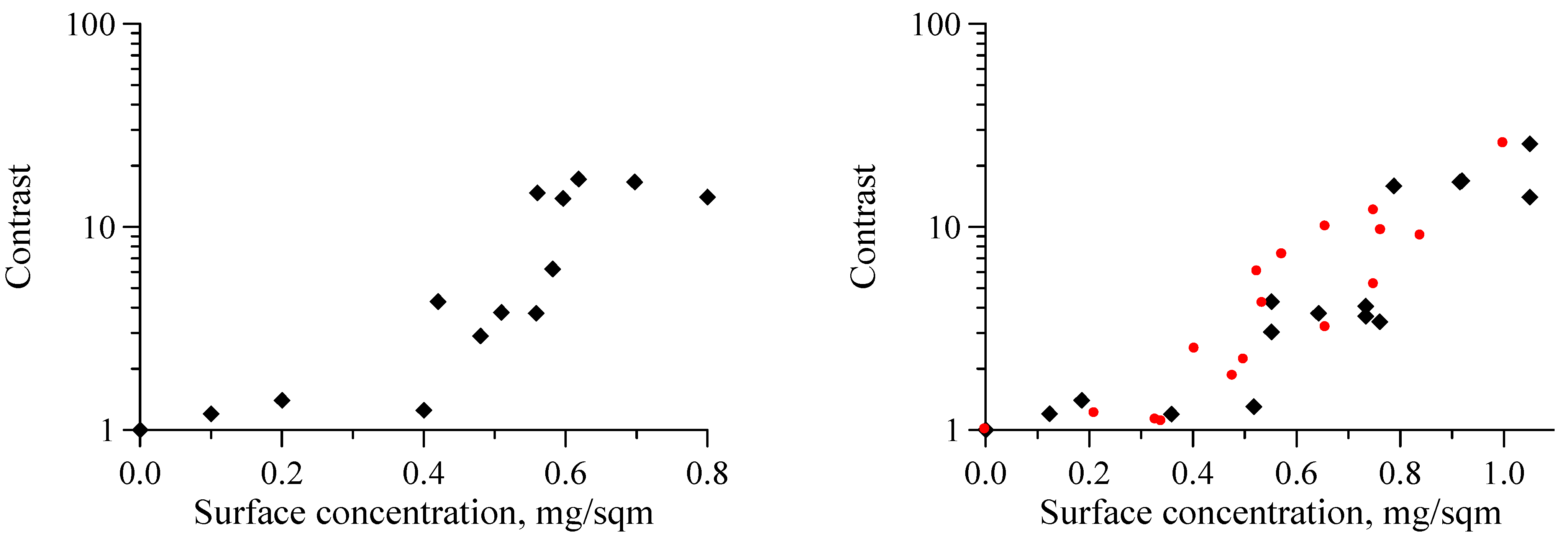
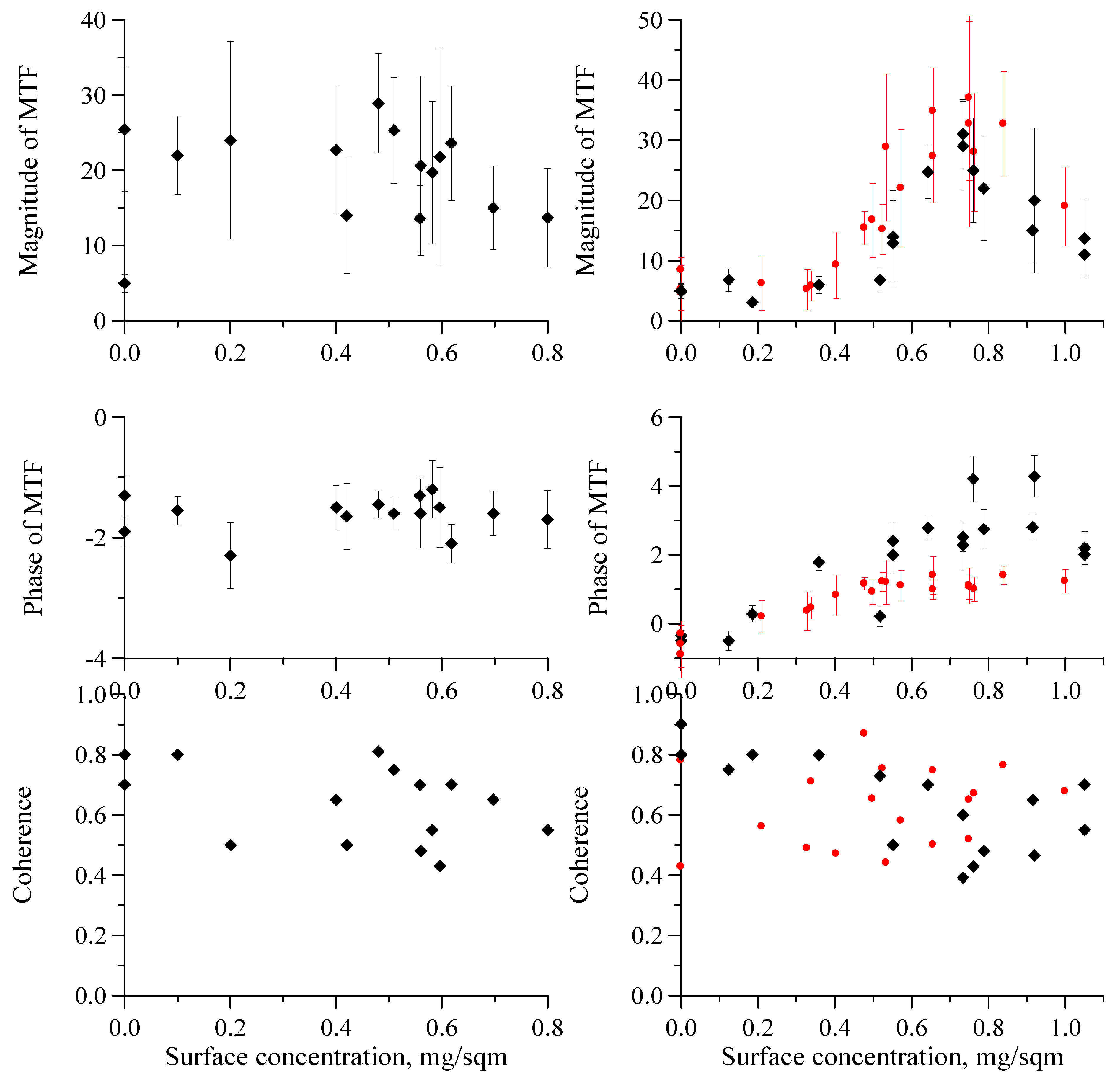
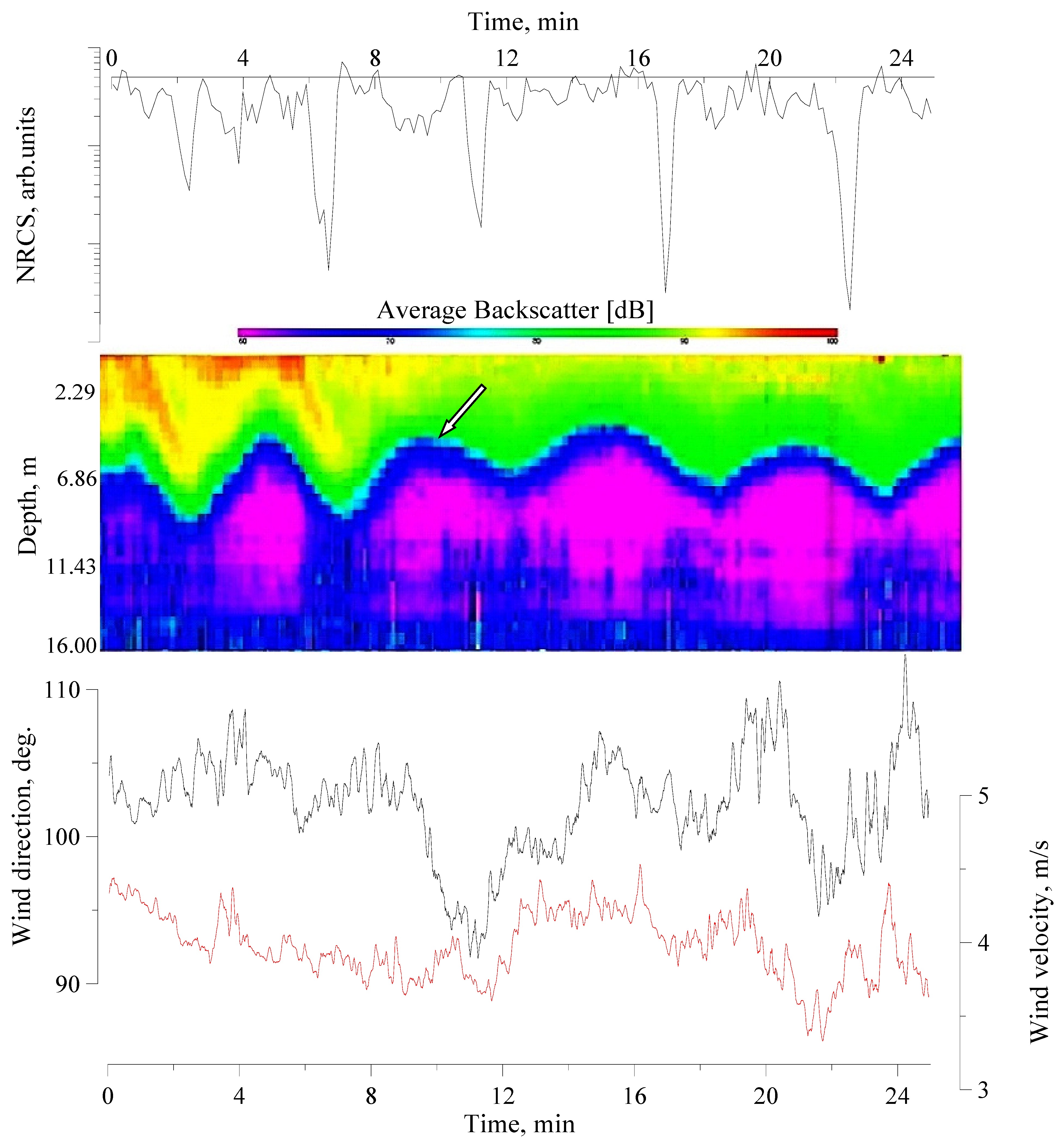
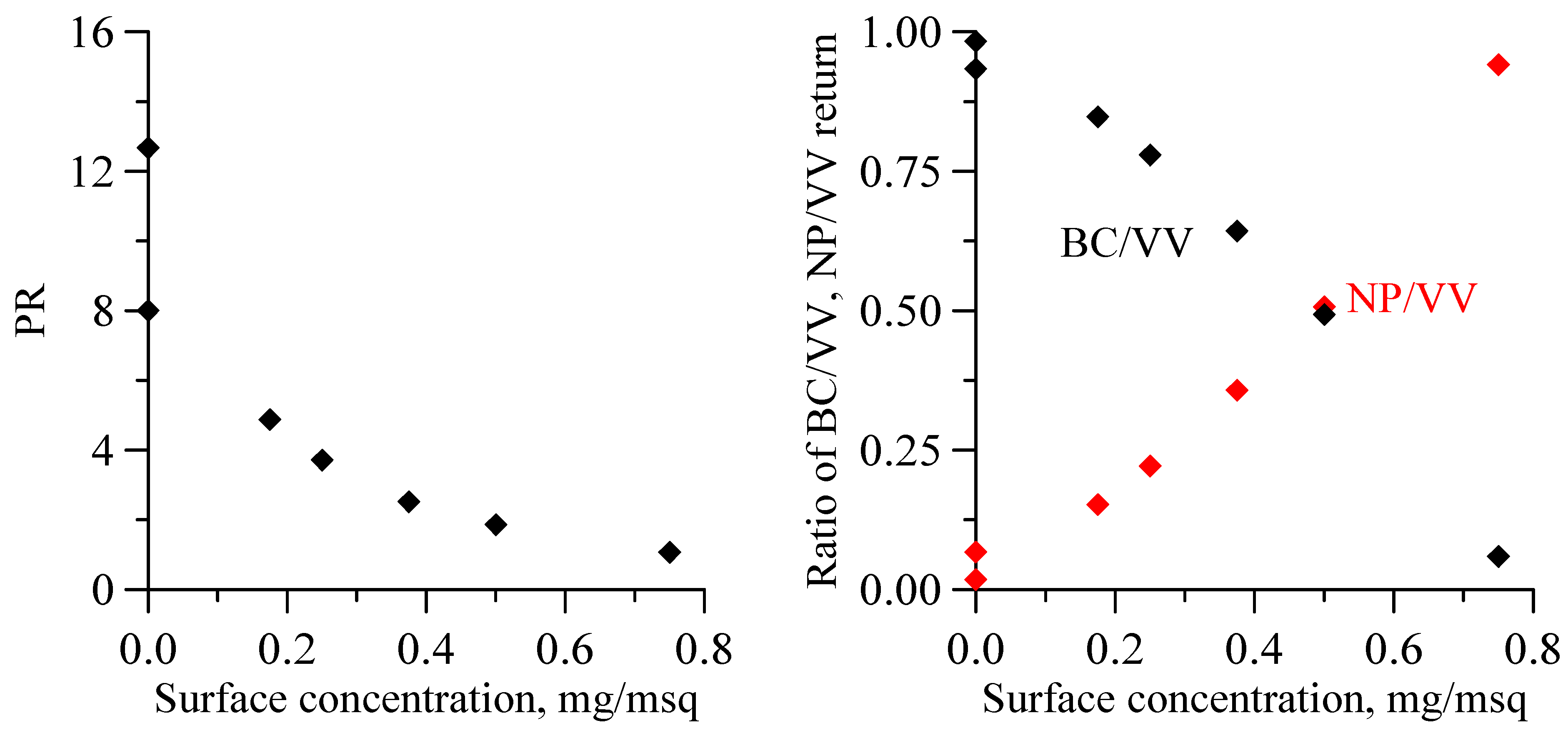


Publisher’s Note: MDPI stays neutral with regard to jurisdictional claims in published maps and institutional affiliations. |
© 2021 by the authors. Licensee MDPI, Basel, Switzerland. This article is an open access article distributed under the terms and conditions of the Creative Commons Attribution (CC BY) license (https://creativecommons.org/licenses/by/4.0/).
Share and Cite
Ermakov, S.A.; Sergievskaya, I.A.; Kapustin, I.A. Strong Modulation of Short Wind Waves and Ka-Band Radar Return Due to Internal Waves in the Presence of Surface Films. Theory and Experiment. Remote Sens. 2021, 13, 2462. https://doi.org/10.3390/rs13132462
Ermakov SA, Sergievskaya IA, Kapustin IA. Strong Modulation of Short Wind Waves and Ka-Band Radar Return Due to Internal Waves in the Presence of Surface Films. Theory and Experiment. Remote Sensing. 2021; 13(13):2462. https://doi.org/10.3390/rs13132462
Chicago/Turabian StyleErmakov, Stanislav A., Irina A. Sergievskaya, and Ivan A. Kapustin. 2021. "Strong Modulation of Short Wind Waves and Ka-Band Radar Return Due to Internal Waves in the Presence of Surface Films. Theory and Experiment" Remote Sensing 13, no. 13: 2462. https://doi.org/10.3390/rs13132462
APA StyleErmakov, S. A., Sergievskaya, I. A., & Kapustin, I. A. (2021). Strong Modulation of Short Wind Waves and Ka-Band Radar Return Due to Internal Waves in the Presence of Surface Films. Theory and Experiment. Remote Sensing, 13(13), 2462. https://doi.org/10.3390/rs13132462






